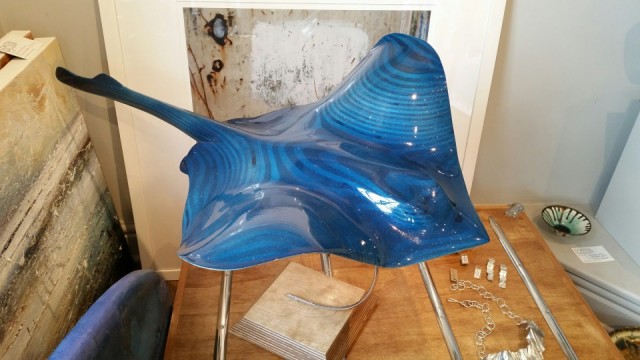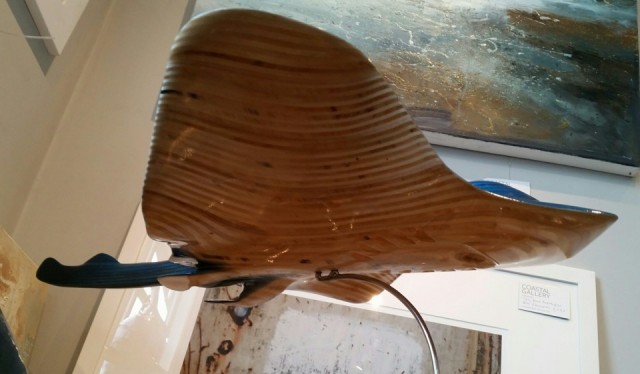December Exhibitions – London
Rose Wylie: Quack Quack Serpentine Sackler
Rose Wylie: Quack Quack Serpentine Sackler
Painting in the Digital Age London based gallery Sophia Contemporary launched a new show exploring how the rise of the Internet and the constant consumption of online images is influencing contemporary painting and painters. “Im/material: Painting in the Digital Age”
A Farewell to Art: Chagall, Shakespeare and Prospero Ben Uri: Art. Identity. Migration
It’s what’s on the inside that counts, at least that’s what my mum says. Rachel Whiteread must have been told the same thing growing up, because the influential British sculptor (and first female winner of the Turner Prize back in 1993) is singularly obsessed with the inside of objects. Over a 25-year career, she has managed to create a powerful, defined, unique aesthetic by disregarding the outside of things and instead examining the emptiness within, often to devastatingly emotional effect. You walk into this show to be confronted by a city turned to ash. The early works are casts of the negative space of a fireplace, a bath, a closet, a hot-water bottle; it looks like the fossilised remains of the entire contents of a lost home. All the walls in the gallery have been pulled out to create an open space, so you can’t really walk through this show chronologically. Instead you stumble from monumental sculpture to monumental sculpture, dwarfed by concrete, plaster and resin. Mattresses lie across one wall, doors and windows across another, a staircase leads to nothing in the middle of the room, a row of bookshelves holds no books, only the impression of them. Tate Britain hasn’t bothered with wall texts here, and the info handout’s pretty flimsy, so it’s left out some important emotional context as a result. The newer works aren’t that exciting either, nor are the works on paper. And you can’t help feeling that most of the bigger works would be happier outside, heaving their heft about in the real world. It all feels a bit mausoleum-ish, like a builders’ merchant in a funeral parlour. But that doesn’t eclipse how great and important most of Whiteread’s art is. There are roots to it – the minimalism of Carl Andre, the resinous structures of Eva Hesse – but she aims for the gut. She uses the ideas of abstraction and minimalism to document very real things. These are tombstones, concrete effigies of moments that are gone for good. There’s death here, lost love and youth. The house that staircase was in is gone, the years she spent sleeping on that mattress are too. This is work about time passing. It screams with thousands of lived moments that are gone for ever, and this is all that remains.
Frieze Sculpture 2017 A free outdoor display in London’s Regent’s Park, 5 July to 8 October Frieze Sculpture is open from 5 July to 8 October, presenting a free outdoor display throughout the summer months. Selected by Clare Lilley (Director of Programme, Yorkshire Sculpture Park) and featuring leading international galleries, Frieze’s first-ever summer display in theEnglish Gardens
The first large-scale exhibition in the UK of the work of American artist Jean-Michel Basquiat (1960—1988). Discover the work of Jean-Michel Basquiat, the pioneering prodigy of the 1980s downtown New York art scene. This unprecedented exhibition brings together an outstanding selection of more than 100 works from international museums and private collections. Engage in the explosive creativity of Basquiat who worked with Andy Warhol, Keith Haring and Blondie, among others. Featuring rare film, photography and archive material, the show captures the spirit of this self-taught artist, poet, DJ and musician whose influence, since his death at 27 in 1988, has been enormous.
The 15th edition of Frieze London takes place from 5–8 October, with a Preview Day on Wednesday, 4 October. More than 160 leading galleries from across the world will showcase ambitious presentations by international emerging and established artists, enhanced by a curated non-profit programme of artist commissions, films and talks. New for 2017, curator Ruba Katrib (SculptureCenter, New York) will co-advise on the Focus section dedicated to emerging galleries; and Ralph Rugoff (Hayward Gallery, London) will curate Frieze Talks for the first time, exploring artists’ response to an age of ‘alternative facts’. The 2017 fair will also feature a new themed gallery section devoted to the legacy of radical feminist artists, curated by Alison Gingeras (independent curator). Frieze London 2017 once more coincides with Frieze Masters and Frieze Sculpture in The Regent’s Park, together forming the heart of Frieze Week, the most significant week in London’s cultural calendar.
Like a rather surreal underwater scene, two beautifully dynamic sharks and a floating sting ray are circling Coastal Gallery this week. Created by Andy Baerselman using resin coated birch wood, these sculptures are both an engineering and an artistic triumph. Ingenious layering of blue resin leaves the grain of the wood showing through to varying degrees across the body of the sculpture, almost as if the light were catching the real thing just below the surface of the sea. Andy’s work has been exhibited across the country, from National Trust properties to super yachts.




